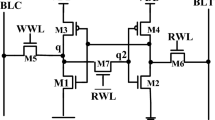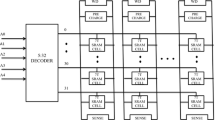Abstract
In terms of memory, multivalued logic can be the fitting logic for the existing binary logic. Ternary logic contains three symbols in place of two symbols used in the binary logic, i.e., 0, 1, 2. More information can be stored with the help of these three symbols. SRAM cell is widely used in the digital circuit. The SRAM cell designed using the ternary logic can be used in the design of large memory arrays designed using ternary logic. The traditional ternary inverter which is used in the design of the traditional ternary SRAM cell is unable to store the proper values for the second state, there is a voltage level drop, which in turn affects the data read/write value of the SRAM cell designed using this traditional ternary inverter. Hence there is a need to design the ternary inverter cell which can give the proper output voltage level of all three states of the ternary logic. The level shift ternary inverter is designed to fulfill this disadvantage. The ternary inverter is designed in order to achieve the ideal DC characteristics, and the same level shift ternary inverter is used in the design of level shift ternary SRAM. This ternary SRAM stores the data properly at read/write signal. The traditional ternary inverter and traditional ternary SRAM, level shift ternary inverter and level shift ternary SRAM are implemented in Cadence 45 nm technology. The traditional ternary inverter consumes 2.37 μW power, and the level shift ternary SRAM consumes 2.43 μW power. The traditional ternary SRAM consumes 3.012 μW and level shift ternary SRAM consumes 3.14 μW. At the cost of a little bit increased power and the number of transistors, the traditional ternary SRAM can be replaced with level shift ternary SRAM. This level shift ternary SRAM stores all the voltage levels at all three levels. The same level shift ternary SRAM cell can be used for the design of large memory arrays.
Access this chapter
Tax calculation will be finalised at checkout
Purchases are for personal use only
Similar content being viewed by others
References
Srinivasa Raghavan B, Kanchana Bhaaskaran VS. Design of novel multiple valued logic (MVL) circuits. In: 2017 International conference on nextgen electronic technologies: silicon to software (ICNETS2), Chennai, India, pp 371–378
Vasundara Patel KS, Gurumurthy KS (2009) Quaternary CMOS combinational logic circuits. In: 2009 international conference on information and multimedia technology, Jeju Island, pp 538–542
Shanmugavadivu P, Sugunadevi S, Sukanya B (2016) Study of static noise margin of SRAM based on supply voltage and topologies. IJAR. ISSN Print 2394-7500, ISSN Online 2394-5869
Srinivasan P, Bhat AS, Murotiya SL, Gupta A (2015) Design and performance evaluation of a low transistor ternary CNTFET SRAM cell. In: 2015 international conference on electronic design, computer networks & automated verification (EDCAV), Shillong, pp 38–43
Moaiyeri MH, Mirzaee RF, Doostaregan A, Navi K, Hashemipour O (2013) A universal method for designing low-power carbon nanotube FET-based multiple valued logic circuits. IET Comput Digital Tech 7(4):167–181
Jahangir MZ, Narasimha KV. Design of a new ternary SRAM cell (ZV-SRAM) based on innovative level shift based ternary inverter (ZV-Inverter). In: Annual India conference (INDICON). IEEE, New Delhi, India, 17–20 Dec 2015
Jayashree HV, Sai Shruthi VP. Ternary SRAM for low power applications. In: International conference on communication, information & computing technology (ICCICT), Mumbai, India, Oct 2012
Author information
Authors and Affiliations
Corresponding author
Editor information
Editors and Affiliations
Rights and permissions
Copyright information
© 2019 Springer Nature Singapore Pte Ltd.
About this paper
Cite this paper
Shylashree, N., Hosur, A., Praveena, N. (2019). Design of Ternary SRAM Cell Based on Level Shift Ternary Inverter. In: Sridhar, V., Padma, M., Rao, K. (eds) Emerging Research in Electronics, Computer Science and Technology. Lecture Notes in Electrical Engineering, vol 545. Springer, Singapore. https://doi.org/10.1007/978-981-13-5802-9_79
Download citation
DOI: https://doi.org/10.1007/978-981-13-5802-9_79
Published:
Publisher Name: Springer, Singapore
Print ISBN: 978-981-13-5801-2
Online ISBN: 978-981-13-5802-9
eBook Packages: EngineeringEngineering (R0)




